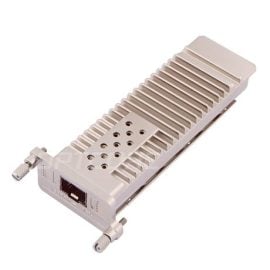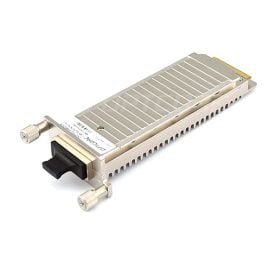Blog, Optical Transceiver
What is the Xenpak Transceiver? A Beginner Guide
Today, let’s discuss an ancient transceiver type: Xenpak. If you are an industry professional with more than 10 years of experience, you should be familiar with it. However, many new professionals are unfamiliar with these terms. That is why we write this post.
Table of contents
What is Xenpak?
Xenpak was first developed around the year 2000 and is the first 10G transceiver type in history. It is a multi-source agreement (MSA) for a 10 Gigabit Ethernet (10GbE) transceiver package. It’s the oldest 10G fiber optic transceiver. Xenpak transceivers are designed with an XAUI interface and a Digital Diagnostic Monitor Interface, which comply with the Xenpak MSA protocol and support the 10 GB Ethernet application of the 802.3ae Ethernet protocol.
Xenpak transceivers are supplied for physical layer interfaces supporting multimode and single-mode fiber optic cables , as well as InfiniBand copper cables, with connectors such as CX4. Transmission distances vary from 100 meters (330 ft) to 80 kilometers (50 mi) on fiber and up to 15 meters (49 ft) on CX4 cable.
Newer Xenpaks using the 10GBase-LX4 standard operated using multiple wavelengths on legacy multimode fibers at distances of up to 300 meters (980 ft), eliminating the need to reinstall cable in a building when upgrading specific 1 Gbit/s circuits to 10 Gbit/s.
Numerous network equipment manufacturers and transceiver optics vendors initially supported the XENPAK form factor. However, advances in technology led to more compact form factors for 10 Gigabit Ethernet applications.
Soon after the standard was introduced in 2001, two related standards emerged: XPAK and X2. These two standards have the same electrical interface as Xenpak (also known as XAUI), but with smaller mechanical properties. Xenpak was replaced by an X2 or SFP+ transceiver, which provides higher port density, and most transceiver vendors stopped providing them to the market.
Nowadays, however, there are several Ethernet switches and routers with Xenpak ports that work, as well as some that do not. A Xenpak to SFP+ converter converter was produced to meet the needs.
Xenpak Transceiver Types
Similar to the other optical transceivers, Xenpak also can be divided into different categories:
#1. Based on Applications
We can categorize them into the following types:
- CWDM Xenpak
- DWDM Xenpak
- Dual Fiber Xenpak
- BiDi Xenpak
- Xenpak SFP+ Converter
#2. Based on Distance
- 10GBase-SR Xenpak: Short reach for 300m distance with 850nm wavelength over OM3 MMF.
- 10GBase-LR Xenpak: Long Reach for 10km distance with 1310nm wavelength over Single Mode SMF.
- 10GBase-LRM Xenpak: Long Reach for 220m distance with 1310nm wavelength over OM3 MMF.
- 10GBase-ER Xenpak: Extend reach to 40km distance with a 1550nm wavelength over Single-Mode SMF.
- 10GBase-ZR Xenpak: Long Hual Reach for 80km distance with 1550nm wavelength over Single Mode SMF.
- 10GBase-EZR Xenpak: Exten Long reach for 100km distance with 1550nm wavelength over Single Mode SMF.
Recommended products
XENPAK Status
Although Xenpak played an important role in the initial release, it was once the rage in the optical module market. However, due to its inherent shortcomings, such as large physical form factor and relatively high power consumption, as well as extremely low port density, it was unable to adapt to the fast-growing telecom, enterprise and data center markets. As a result, it was quickly replaced by the upstarts X2 & XFP, and later by the dominant SFP+.
Today, we rarely see Xenpak on the market. Newer networking devices are basically utilizing smaller and more popular ports such as SFP+, QSFP+, QSFP28, etc. There are almost no vendors offering Xenpak on the market anymore. Few equipment vendors offer switches with Xenpak ports anymore.
The only remaining market demand is limited to maintenance and spare parts replacement for existing legacy equipment. For compatibility with old and new equipment, there are even Xenpak to SFP+ converters/adapters on the market, allowing the use of more modern SFP+ modules in equipment with Xenpak ports.
FAQs
Q: Are Xenpak modules still in widespread use?
No, Xenpak has been largely retired from history. It is only possible to have these ports on some fairly old network equipment and facilities; newer network hardware will no longer be equipped with these older ports.
Q: Can I still buy Xenpak modules?
Although Xenpak modules have been phased out of the market, you can still purchase them from some vendors, such as OPTCORE, or through online second-hand marketplaces and network distributors. However, please note that most second-hand market stores sell refurbished or dismantled Xenpak modules, which may have hidden performance issues. Careful screening is required.
Q: How can I convert the Switch Xenpak port to an SFP+ port?
Please use the Xenpak to SFP+ converter/adapter, which is especially suitable for this application. It helps you extend the life of legacy switches while using modern SFP+ ports.
Final Words
We have introduced the Xenpak, including its history, types, and status, and now you should have a comprehensive understanding of this term. Although we may have very few chances to meet Xenpak, learning about its evolution history allows us to understand that the transceiver development trend is characterized by higher speed, smaller size, lower power consumption, higher density, and increased intelligence.
That is the truth about the development of the transceiver industry. Like the latest QSFP28, OSFP, and QSFP-DD still apply.
Read More:
- What is SFP Module? An Ultimate Guide
- What is SFP Port? Everything You Need to Know
- SFP+, SFP28, QSFP+, QSFP28, QSFP56, QSFP-DD, QSFP112 vs OSFP, What are the differences?
- What is Optical Transceiver: A Beginner Guide











